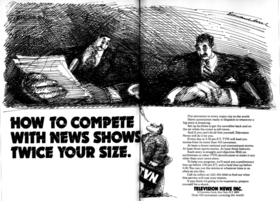KITV is a television station in Honolulu, Hawaii, United States, serving the Hawaiian Islands as an affiliate of ABC. It is owned by Allen Media Group alongside multicultural independent station KIKU. The two stations share studios on South King Street in downtown Honolulu; KITV's main transmitter is located atop the Ala Moana Hotel in Honolulu. Rebroadcasters on the islands of Maui and Hawaii extend the station's signal.
KATU is a television station in Portland, Oregon, United States, affiliated with ABC. It is owned by Sinclair Broadcast Group alongside La Grande–licensed Univision affiliate KUNP. Both stations share studios on NE Sandy Boulevard in Portland, while KATU's transmitter is located in the Sylvan-Highlands section of the city.

The United Network, known prior to launch as the Overmyer Network, was a short lived attempt at a fourth television network in the United States that operated through the month of May 1967. Founded by Daniel H. Overmyer, a Toledo, Ohio, warehouse chain operator and television station owner, majority control of the network was sold by Overmyer to a 14-person syndicate weeks before it launched, resulting in the name change to the United Network.
WFTY-DT is a television station licensed to Smithtown, New York, United States, serving Long Island and owned by TelevisaUnivision. Its main channel broadcasts the True Crime Network; it also rebroadcasts the main channels of its New York City–area Univision and UniMás stations, WXTV-DT and WFUT-DT, from its transmitter in Middle Island, New York.

KMEX-DT is a television station in Los Angeles, serving as the western flagship station of the Spanish-language network Univision. It is owned and operated by TelevisaUnivision alongside Ontario, California–licensed UniMás station KFTR-DT. The two stations share studios on Center Drive in Westchester; KMEX-DT's transmitter is located atop Mount Wilson.

WFUT-DT is a television station licensed to Newark, New Jersey, United States, serving as the UniMás outlet for the New York City area. WFUT-DT is owned and operated by TelevisaUnivision alongside Paterson, New Jersey–licensed Univision station WXTV-DT. The stations share studios on Frank W. Burr Boulevard in Teaneck, New Jersey, and transmitter facilities at the Empire State Building in Midtown Manhattan. The programming of both stations and True Crime Network is simulcast to Long Island and southern Connecticut from WFTY-DT, broadcasting from Middle Island, New York.

KELO-TV is a television station in Sioux Falls, South Dakota, United States, affiliated with CBS, MyNetworkTV, and The CW Plus. The station is owned by Nexstar Media Group, and maintains studios on Phillips Avenue in downtown Sioux Falls; its transmitter is located near Rowena, South Dakota. KELO-TV is broadcast by three high-power semi-satellites—KDLO-TV in Florence, KPLO-TV in Reliance, and KCLO-TV in Rapid City. These transmitters and others, together branded as the KELOLAND Media Group, broadcast KELO programs to all of South Dakota, southwestern Minnesota, and northwestern Iowa, an area the station calls "KELOLAND".

WGTU and WGTQ are television stations in Traverse City and Sault Ste. Marie, Michigan, United States, serving as the ABC affiliates for the northern Lower and eastern Upper peninsulas of Michigan. WGTU and WGTQ are owned by Cunningham Broadcasting; Cunningham contracts with Sinclair Broadcast Group, owner of regional NBC affiliates WPBN-TV and WTOM-TV, to provide services and advertising sales functions. Both stations share studios on M-72 just west of Traverse City; WGTU's transmitter is located east of Kalkaska, Michigan, and WGTQ's is located near Goetzville in southeastern Chippewa County, in addition to simulcasts on WPBN-TV and WTOM-TV's transmitters. The two stations, known as "ABC 29&8" and together with WPBN/WTOM as "UpNorthLive", carry the same programming and together serve one of the largest television markets east of the Mississippi River.
WPXD-TV is a television station licensed to Ann Arbor, Michigan, United States, serving as the Ion Television affiliate for the Detroit area. Owned by Inyo Broadcast Holdings, the station broadcasts from a transmitter on West 11 Mile Road in Southfield, Michigan.

KVOA is a television station in Tucson, Arizona, United States, affiliated with NBC and owned by Allen Media Broadcasting. The station's studios are located on West Elm Street north of downtown Tucson, and its primary transmitter is located atop Mount Bigelow, northeast of the city, supplemented by translators in the Tucson Mountains and in Sierra Vista.

KSBW is a television station licensed to Salinas, California, United States, serving the Monterey Bay area as an affiliate of NBC and ABC. Owned by Hearst Television, the station has studios on John Street in downtown Salinas, and its transmitter is located on Fremont Peak in the Gabilan Mountains.
KUVS-DT is a television station licensed to Modesto, California, United States, broadcasting the Spanish-language Univision network to the Sacramento area. It is owned and operated by TelevisaUnivision alongside Stockton-licensed UniMás outlet KTFK-DT. The two stations share studios on Arden Way near Cal Expo in Sacramento; KUVS-DT's transmitter is located near Valley Springs, California.

KLKN is a television station in Lincoln, Nebraska, United States, affiliated with ABC. Owned by Standard Media, the station maintains studios on 10th Street south of downtown Lincoln and broadcasts from a transmitter located near Utica, Nebraska.

The Nebraska Television Network (NTV) is the ABC affiliate for most of central and western Nebraska. It consists of two full-power stations—KHGI-TV in Kearney, with its transmitter near Lowell, and KWNB-TV in Hayes Center—as well as two low-power stations in McCook and North Platte. NTV is owned by Sinclair Broadcast Group, alongside Lincoln-licensed Fox affiliate KFXL-TV, and operates from studios on Nebraska Highway 44 east of Axtell, about 14 miles (23 km) south of Kearney, with a secondary studio and news bureau at the Conestoga Mall in Grand Island.
WEDQ is a secondary PBS member television station licensed to Tampa, Florida, United States, serving the Tampa Bay area. Owned by Florida West Coast Public Broadcasting, it is a sister station to primary PBS member WEDU. The two stations share studios on North Boulevard in Tampa and transmitter facilities in Riverview, Florida.
KXLF-TV is a television station in Butte, Montana, United States, affiliated with CBS. Owned by the E. W. Scripps Company, it is part of the Montana Television Network (MTN), a statewide network of CBS-affiliated stations. KXLF-TV's studios are located on South Montana Street in downtown Butte, and its transmitter is located on XL Heights east of the city. KXLF-TV and KBZK in Bozeman split the media market, and local news for the Butte area is produced from KBZK's Bozeman studios.
Robert Reinhold Pauley was an American radio broadcasting executive who served as president of the ABC Radio network during a period when it faced challenges from television as the most popular form of mass media.
In American television terminology, a fourth network is a reference to a fourth commercial broadcast (over-the-air) television network, as opposed to the Big Three television networks that dominated U.S. television from the 1950s to the 1980s: ABC, CBS and NBC.

The Public Broadcasting Service (PBS) is an American public broadcaster and non-commercial, free-to-air television network based in Crystal City, Arlington, Virginia. PBS is a publicly funded nonprofit organization and the most prominent provider of educational programs to public television stations in the United States, distributing shows such as Frontline, Nova, PBS NewsHour, Masterpiece, Sesame Street, and This Old House.

WSNS-TV is a television station in Chicago, Illinois, United States, serving as the local outlet for the Spanish-language network Telemundo. It is owned and operated by NBCUniversal's Telemundo Station Group alongside NBC outlet WMAQ-TV ; it is also sister to regional sports network NBC Sports Chicago. WSNS-TV and WMAQ-TV share studios at the NBC Tower on North Columbus Drive in the city's Streeterville neighborhood; both stations are broadcast from the same transmitter atop the Willis Tower in the Chicago Loop.











